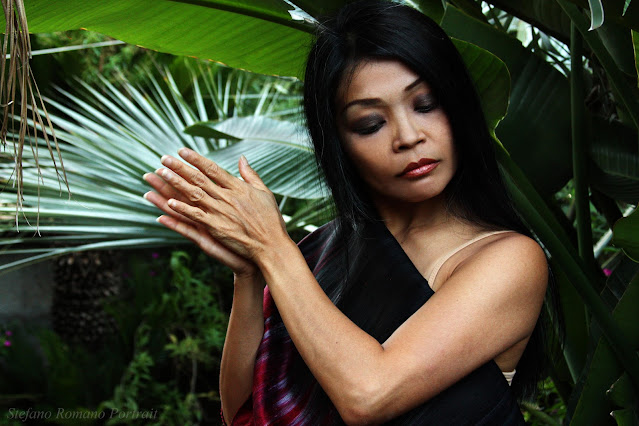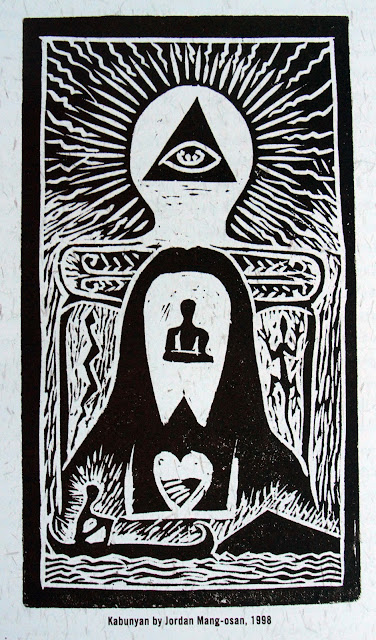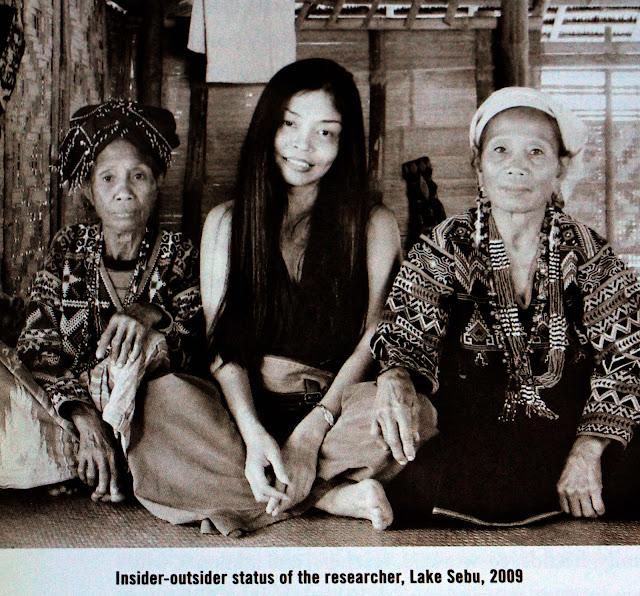 |
| Grace Nono. Rome, July 2013 |
Almost twenty years have passed since I began to frequent the Filipino community in Rome and to get to know their music; it was the pre-social era, I mostly spent my time on a file-sharing site randomly downloading songs from Asia, including many from the Philippines, without understanding a single word, but for me, music has always been more a question of the gut that is not intellectual: what must please me and strike me are the sounds, the melodies, the voices more than the words, so the misunderstanding of the texts have never been a great impediment. This is how I got to know the music of Grace Nono, an artist not too famous among the Filipinos themselves, but with a very warm voice and ethnic melodies.
It so happened that, in July 2013,
Grace was a guest in Rome of a dear friend of mine who, knowing my admiration
for the singer, invited me to meet her. We spent pleasant hours in the
beautiful house of my friend Chato, immersed in her wild garden that seemed to
be in a Philippine forest, also taking the opportunity to take some portraits
of Grace.
She had brought her latest book
along with some music CDs and it was her gift for us. I would then have given
her, thanks to Chato who was returning to the Philippines, one of her portraits
enlarged and framed with a dedication.
These are the magical encounters
that make me thank my passion for Photography every day.
 |  |
That book has been in my mind for years; I often had the intention to talk about it but there was never the right opportunity.
But looking at my last two posts, it
seemed to me that the time had come. What does the story about Cambodia, the
Korean Pansori, and Grace Nono's book have in common? The spirits.
The Cambodian story was almost a
real ghost story, while, regarding the Korean musical recital, I mentioned Jin
Chae-seon, considered the first woman to have performed in Pansori, born in a
fishing village from a shaman mother.
It is therefore not difficult to
imagine what the theme of Grace Nono's book is. Not really the spirits but
certainly the link with their beyond-world.
It is entitled: “Song of Babaylan –
Living voices, medicines, spiritualities of Philippine ritualist-oralist-healers”,
published by the Institute of Spirituality in Asia, in 2013.
A full-bodied tome of nearly 400
pages, full of photographs and lyrics of sacred songs. Therefore it's
impossible for me to talk about it in depth, but I will fly as close as a
dragonfly on the surface of the water.
Through this work Grace also talks about herself as a woman and as an artist. And from her childhood, you understand how she was predestined not only to art but also to one day write this book.
 |
| “Kabunyan” by Jordan Mang-osan, 1998 |
First of all, who are the Babaylan?
Quoting the anthropologist and
scholar of popular traditions Francisco Demetrio, Grace Nono reports the dense
nomenclature referring to the different etymologies of the term according to
the geographical area to which it refers.
From the bailan or balian
in Visaya, Cebu, Bohol, Palawan and Northern Mindanao, babailan in
Negros, balyan among the Negritos; also among the Dayak of Borneo the
priestesses-shamans are called bailan, while in Kelantan, in Malaysia,
they are called belian bomor. The list of nomenclature continues.
Tracing the use of the term babaylan from 1700 to the nineteenth
century, in dictionaries compiled by the Spaniards, Gace Nono reports among the
first definitions that of Father Juan Felix de la Encarnacion in his
Eighteenth-century Diccionario bisaya-espanol: “sacerdotisa entre los
idolatras”, or the woman who conducts magical rituals among those who
worship idols. The fact that the term priest or priestess was used means that
it could have been both a male and a female role, although there are those who,
like the psychologist and art historian Luciano Santiago, push the idea that
the term babaylan comes from the Tagalog “babae lang”, meaning
“purely female, only woman”.
However, what unites every
definition, in every dialect of the different areas of the Philippines, is the
reference to the one who works in contact with the anito (the spirits),
celebrates sacrificial rituals to the diwata (divinities) or to the umalagar
(the spirits of the ancestors). It is important to note that the terms bailan
or balian do not exist in Tagalog, so it's strong the idea that the term
babaylan was introduced in the Philippines from Malayo, or some other
Indo-Malay language.
 |
| Lake Sebu, 2009. Photo by Maria Todi |
Grace Nono's work analyzes the babaylan
of different ethnolinguistic groups, the experiences, and songs of oral
healers, following a path that goes back to the roots and ancestors and at the
same time in the depths of the soul where there is the meeting between human
and divine, not in the dogmatic and cerebral way of classical religions, but as
part of the life of the people who live it, with their myths, proverbs, and
oral codes that are handed down from generations. The fear of losing this
enormous unwritten heritage prompted Grace to work for seven years on this
book, helped by ISA – The Institute of Asian Spirituality, because as Reverend
Christian Buenafe, Commissioner General and ISA member in the introduction of
the book, healing is what we need in these times of division, fractures and
psychic distress, and studying traditional healers helps to understand who we
are.
This is how Grace opens the book,
recounting her childhood, about the fact that she finished this long job shortly
after the death of her beloved mother Ramona; and that the writing, following
the long study, was the medicine and cure for her for the deep pain of this
loss.
She recounts an episode from her
childhood, in the city of Bunawan, in Agusan del Sur in northeastern Mindanao,
south of the Philippines: it was evening and she was lying sick in bed on the
top floor of their house when she heard her father Igmedio call her name from
the courtyard below. Except that he was not addressing her, but shouting her name towards
the night sky; when later Grace asked him what he was doing, her father replied
that he was invoking her soul to come back so that she could heal.
The father, of Ilocano origin, was
not a babaylan, but his life was part of that belief system whereby spirits
were able to capture souls and babaylans could deal with them to return
those souls by healing from disease.
Grace proudly claims the origins of
indigenous descent, from her mother, a native of the Camiguin Island, once
inhabited by the Proto-Manobo of Mindanao, and from an Ilocan father of Nueva
Ecija in central Luzon, from the north to the south of the Philippine. She grew
up with a strong Catholic upbringing, forced by her mother to sing from child,
but when she expressed her desire to become a priestess, her priest replied
that in the Catholic church, women could not become priestesses.
Grace, therefore, enrolled in the High
School of Art in Luzon, where she learned the history of the babaylan, filling
her 15 years with enthusiasm, so much so that she became the subject of her
graduation thesis. After college, instead of becoming a teacher like her
mother, she started her career as a singer, initially copying the Western style as a “good educated Filipina”, she writes with irony. But it didn't take long
for her to realize how foolish it was to copy a style that wasn't quite right,
and it was on a return trip between the mountains of the provinces of Davao and
Bukidnon that she came into contact with babaylan and songs she was completely
ignorant of their existence.
This led her to graduate from the
University of the Philippines with a thesis on oral traditions and to become
the symbolic singer of the deep ethnic and mystical traditions of the
Philippines.
 |  |
The book collects ten babaylan
stories from across the island, with interviews and some of the songs
transcribed. Each of these shamans has her own ritual song.
Reading the interviews is absolutely
interesting, and it is impossible to account for it in this short piece of mine.
Most of the time they are elderly
women, with some slightly younger students who will inherit that oral knowledge
that would otherwise be lost.
Like the first babaylan
interviewed, andadawak Aragoy Tumapang, an expert in Dawak singing in
Tabuk, the capital of the Kalinga region, in the Cordillera of Luzon, in the
north of the Philippines. With her is Gammay Ammakiw who is learning the Dawak
technique in healing rituals.
As she tells Grace, when she
reaches a trance (paramag) during the Dawak's performance, her body
begins to lose sensitivity and expands into something greater than herself:
“Maybe my arungan (the guardian spirit) enters me, making me bigger and
stronger than I really am.”
With this force, they can hoist and
throw even huge pigs onto the ground, possessed by a supernatural force that
helps them heal sick people.
This is a short excerpt from a Dawak
song called “Aragaoy's Owab”:
with your strong powers?
Be on your way now,
go far into the mountains
if it is you that caused
this child's illness.”
 |
| Image of a babaylan in Puerto Princesa. Palawan, 2006. Photo by Charles Wadang |
Or, going down to the south of the
Philippines, in the autonomous Islamic region called Bangsamoro, Datu Odin
Sinsuat in Maguindanao, with the incredible story of the patutunong Babo
Samida expert in Daging singing. This area has always been the stronghold of
Islam in the Philippines, ever since they opposed the Spanish colonial
government in the 1600s, coalescing with the Maranao, Tausag, and other Islamic
groups.
In this context of strong opposition
to the predominant import culture, the preservation of the ancient ancestral
traditions assumed an added value, also because for decades the dominant
religion of Maguindanao was a sort of folk Islam, which however will
become more and more orthodox over time, thanks to the influence of the ustadz,
the teachers of Islam.
And precisely one ustadz is the
husband of Babo Samida, and this will place the two of them in constant
contrast, where the husband rejects everything that is considered pre-Islamic,
but on the other hand, the wife is not absolutely willing to give up to her
beliefs that go back in time and are anchored to ancestral beliefs, while
remaining in the groove marked by Islam, because as the elderly healer tells
us, spirits are creatures of Allah and must be listened to. Thus, while the
orthodox Islamic religious community boycott ritual festivals such as dundang,
Babo Samida refuses to treat the ustadz who search her out when they fall ill.
As Faisal, a patutunong
novice of Babo Samida, says: “Modernity is the other thing that has contributed
to the marginalization of our traditions. Because traditions are seen as
backward, families have stopped teaching our traditions to the young. Hence,
many in this generation no longer understand these things.”
Being a patutunong, a healer,
was never her will, says Babo Samida, but Allah's will and she is happy to be
able to help heal people, as well as pass on the ancient customs of the people
to her.
This is a beautiful Daging
invocation dedicated to Abraham.
“In the name of Allah,
the Highest, and of Allah's prophet...(with) this boat
renamentaw that now pushes forward,
it is my deep and clear desire
that you will take to
the vast ocean, all
illness and heartbreak
among the prophet's followers.”
 |
| Maguindanao patutunong Samida Tato, Quezon City, 2005. Photo by Grace Nono |
 |
| Sapia Mama (center) for whose healing (as well as her grandfather) the dundang ritual was performed. Datu Odin Sinsuat, Maguindanao, 2009. Photo by Grace Nono |
After Babo Samida, Grace reaches
Batangas and the subli matremayo Ka Mila of Catholic tradition, Manobo babaylan
Lordina “undin” in Agusan del Sur, and others, each with its own story and
songs.
There is also a male presence, as
for the Ibalaoi mambunong Henio Estakio, of the Ibaloi ethnic group in
Baguio City, in the north of the Philippines.
Obviously, this is a topic that may
be of more interest to Filipinos who perhaps ignore this part of their
tradition that remains in the shade.
But I believe that it can also be
important for each of us.
After all, as Grace Nono wrote, this
long work of years was a way of getting to know her soul in depth, and at the
same time heal the wound of the loss of her beloved mother.
These songs are addressed directly
to the spirits, create an invisible link between them and us, speak to that
dark area which – in the belief of these healers – is the cause of our
diseases.
 |
| Minang Saling in Tagbanua babaylan garb. Aborlan, Palawan, 2006. Photo by Charles Wandag |
 |
| Cebuano-Visayan sinuog leader/ritualist Estelita “Inday Titang” Diola. Mabolo, Cebu City, 2006. Photo by Grace Nono |
I think this is the most important
point: do not cut or ignore that dark and mysterious part that resides within
us; dialogue with it is the way to avoid falling victim to its aggressions.
As Freud's psychoanalysis taught,
which is not that far from shamanic practice, the way to heal our fears and
neuroses is precisely to give those fears a name.
The cure passes through singing and
speaking.
Call them, talk to them, do not
leave them in their dangerous shadow, but pull them out of their lair to be
able to remove it, like the spirits blown away by the Filipino babaylan.
Recognizing our wounds is the only
way to become a healer of ourselves.
As Grace writes at the end of the
book, in the last lines, this path has not been absolutely easy, and twice she
fell ill from being in contact with the babaylan, without the doctors of
Western medicine being able to cure her. Because the reality of these healers
is that of the spirits, and they are not always benevolent: it can be extremely
dangerous to interact with them.
It is easy to be fascinated by the
magical and spectacular appearance of their rites, but what matters most is
“the state of one's heart, mind, and soul. In the end, we all need guidance and
encouragement to choose the path of love and compassion.”
I close with the splendid prayer of Bishop
Kenneth Cragg, with which Grace herself ends her introduction.
 |
| Grace and me |
*Renamentaw, other name of the boat (biday)


Wow! I learned a lot. I did not know this part of Grace, i only thought she is just using her powerful voice in a very uniqie singing style because that is what she is good at, i was mistaken.
ReplyDeleteBtw, knowing Islam made it clearer to me what spirits are, so i am not surprised that this topic of yours about our old tradition, that is still in practice, have link to it.
I migrated to Palawan and now settled there, and during my last vacation i had this experience (approaching spiritualist). Sensitive to comment though. I just ask Allah(SWT) for guidance and forgiveness.
Thanks for this🌹
Yes, so I share the story of Babo Samida, anyway happy you like it. It's really big deep topic and the book is 400 pages, but this is just a blog 😊✌️
DeleteThe seek of harmony between body and spirit... which is the seat of emotion...the character...the soul...the courage...and determination that helps people to survive...to keep their way of life...and their beliefs.
ReplyDeleteYes, like Grace wrote last.. Path of love and compassion 🙏
Delete